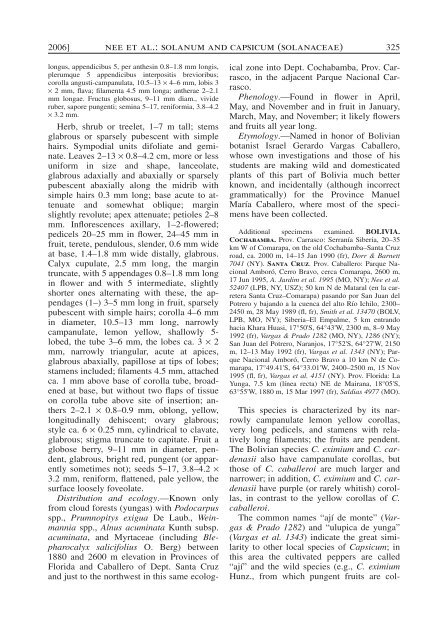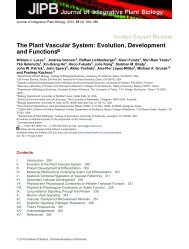New species of Solanum and Capsicum (Solanaceae) from Bolivia ...
New species of Solanum and Capsicum (Solanaceae) from Bolivia ...
New species of Solanum and Capsicum (Solanaceae) from Bolivia ...
You also want an ePaper? Increase the reach of your titles
YUMPU automatically turns print PDFs into web optimized ePapers that Google loves.
2006] nee et al.: solanum <strong>and</strong> capsicum (solanaceae) 325<br />
longus, appendicibus 5, per anthesin 0.8–1.8 mm longis,<br />
plerumque 5 appendicibus interpositis brevioribus;<br />
corolla angusti-campanulata, 10.5–13 × 4–6 mm, lobis 3<br />
× 2 mm, flava; filamenta 4.5 mm longa; antherae 2–2.1<br />
mm longae. Fructus globosus, 9–11 mm diam., vivide<br />
ruber, sapore pungenti; semina 5–17, reniformia, 3.8–4.2<br />
× 3.2 mm.<br />
Herb, shrub or treelet, 1–7 m tall; stems<br />
glabrous or sparsely pubescent with simple<br />
hairs. Sympodial units difoliate <strong>and</strong> geminate.<br />
Leaves 2–13 × 0.8–4.2 cm, more or less<br />
uniform in size <strong>and</strong> shape, lanceolate,<br />
glabrous adaxially <strong>and</strong> abaxially or sparsely<br />
pubescent abaxially along the midrib with<br />
simple hairs 0.3 mm long; base acute to attenuate<br />
<strong>and</strong> somewhat oblique; margin<br />
slightly revolute; apex attenuate; petioles 2–8<br />
mm. Inflorescences axillary, 1–2-flowered;<br />
pedicels 20–25 mm in flower, 24–45 mm in<br />
fruit, terete, pendulous, slender, 0.6 mm wide<br />
at base, 1.4–1.8 mm wide distally, glabrous.<br />
Calyx cupulate, 2.5 mm long, the margin<br />
truncate, with 5 appendages 0.8–1.8 mm long<br />
in flower <strong>and</strong> with 5 intermediate, slightly<br />
shorter ones alternating with these, the appendages<br />
(1–) 3–5 mm long in fruit, sparsely<br />
pubescent with simple hairs; corolla 4–6 mm<br />
in diameter, 10.5–13 mm long, narrowly<br />
campanulate, lemon yellow, shallowly 5lobed,<br />
the tube 3–6 mm, the lobes ca. 3 × 2<br />
mm, narrowly triangular, acute at apices,<br />
glabrous abaxially, papillose at tips <strong>of</strong> lobes;<br />
stamens included; filaments 4.5 mm, attached<br />
ca. 1 mm above base <strong>of</strong> corolla tube, broadened<br />
at base, but without two flaps <strong>of</strong> tissue<br />
on corolla tube above site <strong>of</strong> insertion; anthers<br />
2–2.1 × 0.8–0.9 mm, oblong, yellow,<br />
longitudinally dehiscent; ovary glabrous;<br />
style ca. 6 × 0.25 mm, cylindrical to clavate,<br />
glabrous; stigma truncate to capitate. Fruit a<br />
globose berry, 9–11 mm in diameter, pendent,<br />
glabrous, bright red, pungent (or apparently<br />
sometimes not); seeds 5–17, 3.8–4.2 ×<br />
3.2 mm, reniform, flattened, pale yellow, the<br />
surface loosely foveolate.<br />
Distribution <strong>and</strong> ecology.—Known only<br />
<strong>from</strong> cloud forests (yungas) with Podocarpus<br />
spp., Prumnopitys exigua De Laub., Weinmannia<br />
spp., Alnus acuminata Kunth subsp.<br />
acuminata, <strong>and</strong> Myrtaceae (including Blepharocalyx<br />
salicifolius O. Berg) between<br />
1880 <strong>and</strong> 2600 m elevation in Provinces <strong>of</strong><br />
Florida <strong>and</strong> Caballero <strong>of</strong> Dept. Santa Cruz<br />
<strong>and</strong> just to the northwest in this same ecolog-<br />
ical zone into Dept. Cochabamba, Prov. Carrasco,<br />
in the adjacent Parque Nacional Carrasco.<br />
Phenology.—Found in flower in April,<br />
May, <strong>and</strong> November <strong>and</strong> in fruit in January,<br />
March, May, <strong>and</strong> November; it likely flowers<br />
<strong>and</strong> fruits all year long.<br />
Etymology.—Named in honor <strong>of</strong> <strong>Bolivia</strong>n<br />
botanist Israel Gerardo Vargas Caballero,<br />
whose own investigations <strong>and</strong> those <strong>of</strong> his<br />
students are making wild <strong>and</strong> domesticated<br />
plants <strong>of</strong> this part <strong>of</strong> <strong>Bolivia</strong> much better<br />
known, <strong>and</strong> incidentally (although incorrect<br />
grammatically) for the Province Manuel<br />
María Caballero, where most <strong>of</strong> the specimens<br />
have been collected.<br />
Additional specimens examined. BOLIVIA.<br />
Cochabamba. Prov. Carrasco: Serranía Siberia, 20–35<br />
km W <strong>of</strong> Comarapa, on the old Cochabamba–Santa Cruz<br />
road, ca. 2000 m, 14–15 Jan 1990 (fr), Dorr & Barnett<br />
7041 (NY). Santa Cruz. Prov. Caballero: Parque Nacional<br />
Amboró, Cerro Bravo, cerca Comarapa, 2600 m,<br />
17 Jun 1995, A. Jardim et al. 1995 (MO, NY); Nee et al.<br />
52407 (LPB, NY, USZ); 50 km N de Mataral (en la carretera<br />
Santa Cruz–Comarapa) pas<strong>and</strong>o por San Juan del<br />
Potrero y baj<strong>and</strong>o a la cuenca del alto Río Ichilo, 2300–<br />
2450 m, 28 May 1989 (fl, fr), Smith et al. 13470 (BOLV,<br />
LPB, MO, NY); Siberia–El Empalme, 5 km entr<strong>and</strong>o<br />
hacia Khara Huasi, 17°50'S, 64°43'W, 2300 m, 8–9 May<br />
1992 (fr), Vargas & Prado 1282 (MO, NY), 1286 (NY);<br />
San Juan del Potrero, Naranjos, 17°52'S, 64°27'W, 2150<br />
m, 12–13 May 1992 (fr), Vargas et al. 1343 (NY); Parque<br />
Nacional Amboró, Cerro Bravo a 10 km N de Comarapa,<br />
17°49.41'S, 64°33.01'W, 2400–2500 m, 15 Nov<br />
1995 (fl, fr), Vargas et al. 4151 (NY). Prov. Florida: La<br />
Yunga, 7.5 km (línea recta) NE de Mairana, 18°05'S,<br />
63°55'W, 1880 m, 15 Mar 1997 (fr), Saldias 4977 (MO).<br />
This <strong>species</strong> is characterized by its narrowly<br />
campanulate lemon yellow corollas,<br />
very long pedicels, <strong>and</strong> stamens with relatively<br />
long filaments; the fruits are pendent.<br />
The <strong>Bolivia</strong>n <strong>species</strong> C. eximium <strong>and</strong> C. cardenasii<br />
also have campanulate corollas, but<br />
those <strong>of</strong> C. caballeroi are much larger <strong>and</strong><br />
narrower; in addition, C. eximium <strong>and</strong> C. cardenasii<br />
have purple (or rarely whitish) corollas,<br />
in contrast to the yellow corollas <strong>of</strong> C.<br />
caballeroi.<br />
The common names “ají de monte” (Vargas<br />
& Prado 1282) <strong>and</strong> “ulupica de yunga”<br />
(Vargas et al. 1343) indicate the great similarity<br />
to other local <strong>species</strong> <strong>of</strong> <strong>Capsicum</strong>; in<br />
this area the cultivated peppers are called<br />
“ají” <strong>and</strong> the wild <strong>species</strong> (e.g., C. eximium<br />
Hunz., <strong>from</strong> which pungent fruits are col-
















